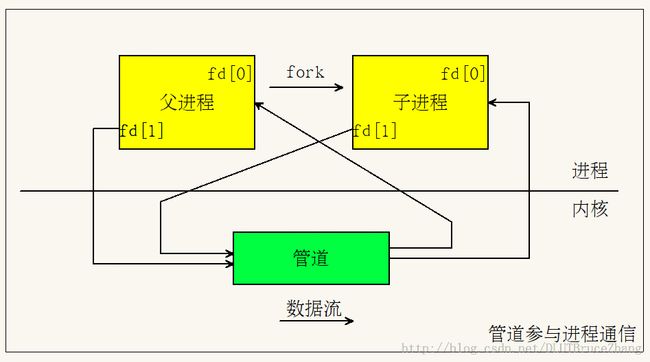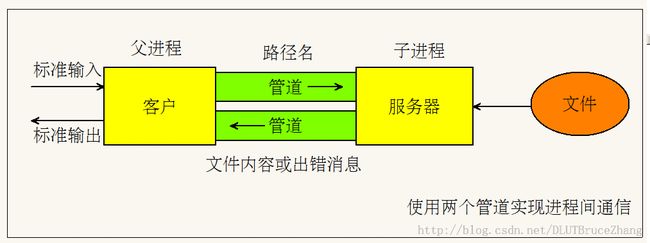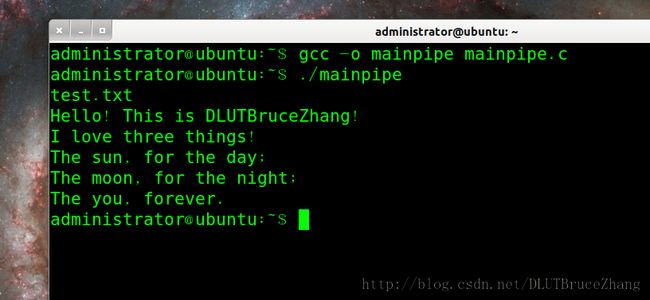Unix网络编程--进程间通信--管道通信
所有式样的Unix都提供管道,它由 pipe 函数创建,提供一个单路(单向)数据流。
原型如下:
#include <unistd.h> int pipe(int fd[2]);
该函数返回两个文件描述符:fd[0] fd[1]。前者打开用于读,后者打开来写。(都是站在进程的角度上来看读和写)
管道的典型用途是以下述方式为两个不同的进程(一个是父进程,一个是子进程)提供进程间的通信手段。首先,由一个进程创建管道后调用 fork 派生出一个自身的副本,过程如下所示:
注意:其实上面这张图说明的道理没有问题,但是图的画法确实是存在问题的。因为管道是单向传输数据流的,所以,当有两个不同的进程进行通信时,需要的是两个管道协同合作,而不是上图的画法。我们可以考虑一种情况,当父进程或者是子进程往管道里写入数据,因为管道里只要有数据就可以读出,所以,如果这时如果父进程或者是子进程读管道中的数据,那么读出的可能就是刚刚写入的数据,这样,就没能完成通信的任务。
所以,如果要实现通信,正确的步骤是:
(1)创建管道1( fd1[0] 和 fd1[1] )和管道( fd2[0] 和 fd2[1] )
(2)fork;
(3)父进程关闭管道1的读出端
(4)父进程关闭管道2的写入端
(5)子进程关闭管道1的写入端
(6)子进程关闭管道2的读出端
完成了以上步骤就好像下面这张图这样:
例子:
现在描述一个客户端-服务器的例子。main 函数创建两个管道并用 fork 生成一个子进程。客户然后作为父进程运行,服务器则作为子进程运行。第一个管道用于从客户向服务器发送路径名,第二个管道用于从服务器向客户发送该文件的内容(或者是一个出错消息),这样设置完毕后就得到下图所示的情形:
下面请看实现的实例程序:
mainpipe.c
#include <sys/types.h> /* basic system data types */
#include <sys/time.h> /* timeval{} for select() */
#include <time.h> /* timespec{} for pselect() */
#include <errno.h>
#include <fcntl.h> /* for nonblocking */
#include <limits.h> /* PIPE_BUF */
#include <signal.h>
#include <stdio.h>
#include <stdlib.h>
#include <string.h>
#include <sys/stat.h> /* for S_xxx file mode constants */
#include <unistd.h>
#include <sys/wait.h>
#define MAXLINE 1024
void client(int, int);
void server(int, int);
int main(int argc, char **argv)
{
int pipe1[2], pipe2[2];
pid_t childpid;
pipe(pipe1);
pipe(pipe2);
if ((childpid = fork()) == 0) {
close(pipe1[1]);
close(pipe2[0]);
server(pipe1[0], pipe2[1]);
exit(0);
}
close(pipe1[0]);
close(pipe2[1]);
client(pipe2[0], pipe1[1]);
waitpid(childpid, NULL, 0);
exit(0);
}
void client(int readfd, int writefd)
{
size_t len;
ssize_t n;
char buff[MAXLINE];
fgets(buff, MAXLINE, stdin);
len = strlen(buff);
if (buff[len - 1] == '\n')
len--;
write(writefd, buff, len);
while ((n = read(readfd, buff, MAXLINE)) > 0)
write(STDOUT_FILENO, buff, n);
}
void server(int readfd, int writefd)
{
int fd;
ssize_t n;
char buff[MAXLINE+1];
if ( (n = read(readfd, buff, MAXLINE)) == 0) {
printf("end-of-file while reading pathname");
exit(-1);
}
buff[n] = '\0';
if ( (fd = open(buff, O_RDONLY)) < 0) {
snprintf(buff + n, sizeof(buff) - n, ": can't open, %s\n", strerror(errno));
n = strlen(buff);
write(writefd, buff, n);
} else {
while( (n = read(fd, buff, MAXLINE)) > 0)
write(writefd, buff, n);
close(fd);
}
}
我在主目录下放置文件 test.txt,文件内容如下所示:
Hello! This is DLUTBruceZhang! I love three things! The sun, for the day; The moon, for the night; The you, forever.
编译运行程序得到如下输出:
由此可见,利用管道实现了进程间通信。



